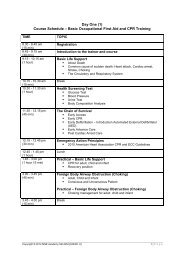Eric lippert - Amazon Web Services
Eric lippert - Amazon Web Services
Eric lippert - Amazon Web Services
You also want an ePaper? Increase the reach of your titles
YUMPU automatically turns print PDFs into web optimized ePapers that Google loves.
09<br />
Housekeeping databases<br />
If you have transactional tables where records get inserted very<br />
frequently and unless you remove older records from the table, you<br />
run out of space within weeks; then it is a challenge to periodically<br />
purge such tables, without bringing down the tables. If you have<br />
a 24x7 website, then it becomes very difficult to find a slot where<br />
you can take an outage and do a purge that takes on an average of<br />
15-30 mins to finish. During purge operations, the table gets locked<br />
and all other queries on that table times out. So, you need to find<br />
a way to purge records consuming the least amount of database<br />
resource.<br />
delete from @BatchIds<br />
Set @rowCount = @@rowCount;<br />
Print ‘Deleted ‘ + convert(varchar(10), @rowcount) + ‘<br />
rows...’<br />
waitfor delay ‘00:00:05’<br />
End;<br />
go<br />
Checkpoint 30; -- simple recovery, if full - put tlog<br />
backup here<br />
Go<br />
There are various ways to do this but we found the following<br />
approach having the least footprint on the database:<br />
Declare @batchsize int; Set @batchsize = 1000;<br />
set transaction isolation level read uncommitted; set<br />
nocount on;<br />
declare @temp_rows_to_delete table (ID int primary key)<br />
insert into @temp_rows_to_delete select ID FROM<br />
VeryLargeTable WHERE ID < 4000<br />
Declare @rowCount int; Set @rowCount = 1;<br />
declare @BatchIds table (id int primary key)<br />
While @rowCount > 0<br />
Begin<br />
-- Pick the IDs to delete and remove them from #temp_rows<br />
delete top(@batchsize) from @temp_rows_to_delete<br />
OUTPUT deleted.ID into @BatchIds<br />
delete from VeryLargeTable WHERE ID IN (SELECT ID FROM @<br />
BatchIds)<br />
The idea here is to do a steady small batch of delete at a time until<br />
all the records we want to purge are deleted. This query can go<br />
on for hours, not a problem. But during that time, there will be no<br />
significant stress on the database to cause other queries to timeout<br />
or degrade significantly.<br />
First we set the isolation level. This is absolutely a key thing to<br />
do. This isolation level tells SQL Server that the following query<br />
does not need locking. It can read dirty data, does not matter. So,<br />
there’s no reason for SQL Server to lock records in order to ensure<br />
the query gets properly committed data. Unless you are a bank, you<br />
should put this in all your stored procs and you will see 10 times<br />
better throughput sometimes from your database, for read queries.<br />
Next we read the row IDs from the source table and store in a table<br />
variable. This is the only time we are going to do a SELECT on the<br />
source table so that SQL Server does not have to scan the large<br />
table again and again.<br />
Then we keep picking 1000 row IDs at a time and delete the rows<br />
from the table. After each delete, we give SQL Server 5 seconds to<br />
rest and flush the logs.<br />
10<br />
Tuning database indexes<br />
Over the time, data in tables get fragmented as data gets inserted,<br />
updated and deleted. If you leave the tables alone, the indexes will<br />
get slower and slower resulting in slower queries. If you have<br />
millions of records on a table and you start having significant<br />
fragmentation on the tables, over the time, queries will get so slow<br />
that they will start timing out.<br />
In order to keep the tables fast and lean, you need to regularly<br />
rebuild the indexes. Here’s a SQL snippet that will run through<br />
all the indexes on the database and see if the indexes are heavily<br />
fragmented. If they are, then it will issue an index rebuild on them.<br />
Ref: http://www.mssqltips.com/sqlservertip/1165/managing-sqlserver-database-fragmentation/<br />
10 | DNCmagazine www.dotnetcurry.com

















